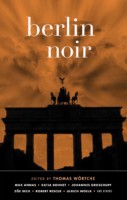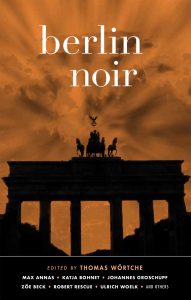BERLIN NOIR

The Berlin-based THOMAS WÖRTCHE is a latter-day Renaissance man of German Literature with specialties in crime fiction and thrillers. Name a top German publication, and Thomas Wörtche most likely has contributed to it.
Here’s something Thomas Przybilka has said about Wörtche:
“Wörtche’s view of crime fiction is expansive, because his activities are not restricted to this literary genre. His interests include music, comics, history, art history and – of course – literature as a whole. His credo is: ‘If all you know is crime fiction, you don’t really understand crime fiction at all.’”
Recently, Wörtche collected and edited the constituent short stories of BERLIN NOIR, a volume of high-quality noir set in present-day Berlin.
By email exchange, I conducted the following interview with Mr. Wörtche.
***
BERLIN NOIR is available in both German and English. What was the genesis of these two editions? And had you seen these short stories elsewhere, or did you commission them for this book?
BERLIN NOIR was originally commissioned by the Brooklyn-based Akashic Books for their terrific NOIR series, which features single volumes dedicated to a city, state or geographical area. For example, there’s a BRONX NOIR, a CAPE COD NOIR and a BRUSSELS NOIR.
Like all titles in the NOIR series, BERLIN NOIR contains original stories only. I scouted for appropriate authors and asked them to contribute. Even though Akashic is an American publisher, the stories were published in their original German version before the volume appeared in English translation. Just one of the stories in this book was originally in English, KADDISH FOR LAZAR by Michael Wuliger.
Of the writers who contributed short stories to Berlin Noir, which have published full-length books in English that you might recommend to my readers?
This was not a criterion for my selection, but off the top of my head, I think Zoë Beck, Katja Bohnet and Max Annas all have at least one book available in English.
(Ed. — On Amazon, Zoë Beck’s novel FADE TO BLACK is here, Katya Bohnet’s short story collection THREADS IN DEW is here, and Max Annas’s novel THE WALL is here.)
In your introduction to BERLIN NOIR, you make the excellent point that Berlin’s official districts are administrative entities, but the authentic sociological aspects of the city run according to smaller cities-within-the-city, that is, neighborhoods or Kiez. Of the Kiez included in the BERLIN NOIR stories, please tell us about one Kiez that is among your favorites, and how your attachment to it informed your enjoyment of the story.
A funny little anecdote illustrates the truism that Berliners tend to keep to their own Kiez.
Recently, the Wedding-based writer Robert Rescue appeared at an event in Kreuzberg. An audience member, rather surprised by the circumstance, knowingly asked him: “What are you doing abroad?”
Personally, I’m a bit different, in that I like to switch between the kiezes. Even though I live in Charlottenburg, I sometimes feel Kreuzberg is my favorite. Johannes Groschupf´s story HEINRICHPLATZBLUES vividly portrays an atmosphere there. It´s not just the location; it’s the sound of the place as well as how the people there speak and think and feel.
Finding the perfect author for each Kiez was quite an undertaking. I know the city pretty well – having lived here 30 years – yet there are still things and neighborhoods for me to discover.
Michael Wuliger’s contribution to BERLIN NOIR – KADDISH FOR LAZAR – is wickedly clever and funny. Which aspects of this story do you consider to be ‘noir’?
The late, great French crime novelist Jean-Patrick Manchette once pointed out that POLAR – (a word sometimes used in French to signify ‘noir’) — is comprised of crime, violence, politics, argot and humor. Voilà, there you have Mike’s noir-story KADDISH FOR LAZAR. Additionally, of course, there’s the “mean thinking” – an important aspect of noir.
***
BERLIN NOIR is available on Amazon here, on Barnes & Noble here, and from the publisher, Akashic Books here.

